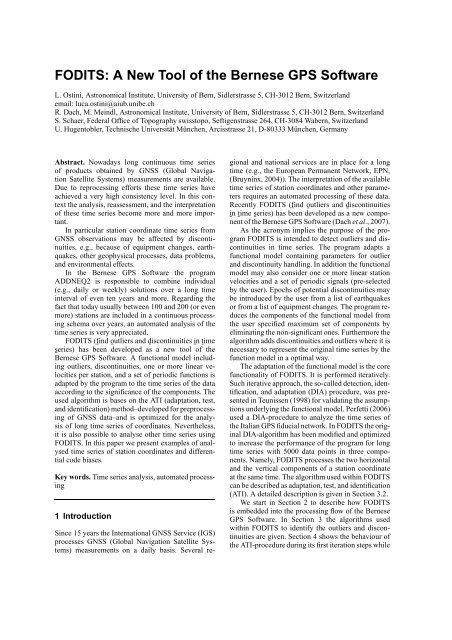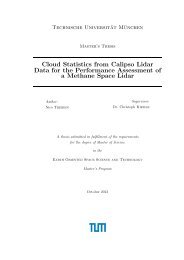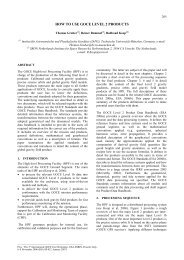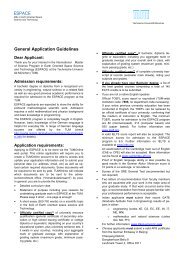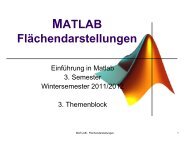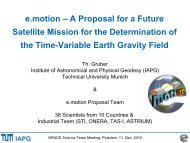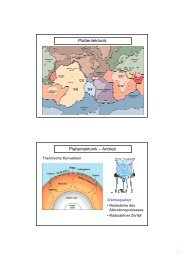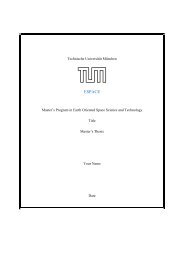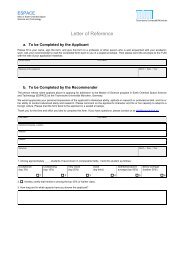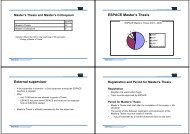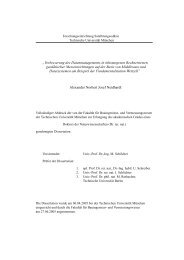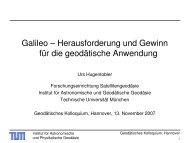FODITS - Institut für Astronomische und Physikalische Geodäsie ...
FODITS - Institut für Astronomische und Physikalische Geodäsie ...
FODITS - Institut für Astronomische und Physikalische Geodäsie ...
Create successful ePaper yourself
Turn your PDF publications into a flip-book with our unique Google optimized e-Paper software.
<strong>FODITS</strong>: A New Tool of the Bernese GPS Software<br />
L. Ostini, Astronomical <strong>Institut</strong>e, University of Bern, Sidlerstrasse 5, CH-3012 Bern, Switzerland<br />
email: luca.ostini@aiub.unibe.ch<br />
R. Dach, M. Meindl, Astronomical <strong>Institut</strong>e, University of Bern, Sidlerstrasse 5, CH-3012 Bern, Switzerland<br />
S. Schaer, Federal Office of Topography swisstopo, Seftigenstrasse 264, CH-3084 Wabern, Switzerland<br />
U. Hugentobler, Technische Universität München, Arcisstrasse 21, D-80333 München, Germany<br />
Abstract. Nowadays long continuous time series<br />
of products obtained by GNSS (Global Navigation<br />
Satellite Systems) measurements are available.<br />
Due to reprocessing efforts these time series have<br />
achieved a very high consistency level. In this context<br />
the analysis, reassessment, and the interpretation<br />
of these time series become more and more important.<br />
In particular station coordinate time series from<br />
GNSS observations may be affected by discontinuities,<br />
e.g., because of equipment changes, earthquakes,<br />
other geophysical processes, data problems,<br />
and environmental effects.<br />
In the Bernese GPS Software the program<br />
ADDNEQ2 is responsible to combine individual<br />
(e.g., daily or weekly) solutions over a long time<br />
interval of even ten years and more. Regarding the<br />
fact that today usually between 100 and 200 (or even<br />
more) stations are included in a continuous processing<br />
schema over years, an automated analysis of the<br />
time series is very appreciated.<br />
<strong>FODITS</strong> (f ¯ ind ōutliers and d ¯ iscontinuities īn t ¯ ime<br />
s ¯ eries) has been developed as a new tool of the<br />
Bernese GPS Software. A functional model including<br />
outliers, discontinuities, one or more linear velocities<br />
per station, and a set of periodic functions is<br />
adapted by the program to the time series of the data<br />
according to the significance of the components. The<br />
used algorithm is bases on the ATI (adaptation, test,<br />
and identification) method–developed for preprocessing<br />
of GNSS data–and is optimized for the analysis<br />
of long time series of coordinates. Nevertheless,<br />
it is also possible to analyse other time series using<br />
<strong>FODITS</strong>. In this paper we present examples of analysed<br />
time series of station coordinates and differential<br />
code biases.<br />
Key words. Time series analysis, automated processing<br />
1 Introduction<br />
Since 15 years the International GNSS Service (IGS)<br />
processes GNSS (Global Navigation Satellite Systems)<br />
measurements on a daily basis. Several re-<br />
gional and national services are in place for a long<br />
time (e.g., the European Permanent Network, EPN,<br />
(Bruyninx, 2004)). The interpretation of the available<br />
time series of station coordinates and other parameters<br />
requires an automated processing of these data.<br />
Recently <strong>FODITS</strong> (find ōutliers and discontinuities i<br />
¯ ¯<br />
¯ n t ¯ ime series) has been developed as a new component<br />
of the ¯ Bernese GPS Software (Dach et al., 2007).<br />
As the acronym implies the purpose of the program<br />
<strong>FODITS</strong> is intended to detect outliers and discontinuities<br />
in time series. The program adapts a<br />
functional model containing parameters for outlier<br />
and discontinuity handling. In addition the functional<br />
model may also consider one or more linear station<br />
velocities and a set of periodic signals (pre-selected<br />
by the user). Epochs of potential discontinuities may<br />
be introduced by the user from a list of earthquakes<br />
or from a list of equipment changes. The program reduces<br />
the components of the functional model from<br />
the user specified maximum set of components by<br />
eliminating the non-significant ones. Furthermore the<br />
algorithm adds discontinuities and outliers where it is<br />
necessary to represent the original time series by the<br />
function model in a optimal way.<br />
The adaptation of the functional model is the core<br />
functionality of <strong>FODITS</strong>. It is performed iteratively.<br />
Such iterative approach, the so-called detection, identification,<br />
and adaptation (DIA) procedure, was presented<br />
in Teunissen (1998) for validating the assumptions<br />
<strong>und</strong>erlying the functional model. Perfetti (2006)<br />
used a DIA-procedure to analyze the time series of<br />
the Italian GPS fiducial network. In <strong>FODITS</strong> the original<br />
DIA-algorithm has been modified and optimized<br />
to increase the performance of the program for long<br />
time series with 5000 data points in three components.<br />
Namely, <strong>FODITS</strong> processes the two horizontal<br />
and the vertical components of a station coordinate<br />
at the same time. The algorithm used within <strong>FODITS</strong><br />
can be described as adaptation, test, and identification<br />
(ATI). A detailed description is given in Section 3.2.<br />
We start in Section 2 to describe how <strong>FODITS</strong><br />
is embedded into the processing flow of the Bernese<br />
GPS Software. In Section 3 the algorithms used<br />
within <strong>FODITS</strong> to identify the outliers and discontinuities<br />
are given. Section 4 shows the behaviour of<br />
the ATI-procedure during its first iteration steps while
analyzing CODE (Center for Orbit Determination in<br />
Europe) coordinate time series. The paper gives examples<br />
for processed weekly coordinate time series<br />
for some of the stations in the EPN in Section 5.1.<br />
Section 5.2 illustrates an example of the reassessment<br />
of CODE global daily station coordinate time series.<br />
The analysis of the P1-P2 DCB (Differential Code<br />
Biases) is presented as an example for the processing<br />
of non-coordinate one-dimensional time series in<br />
Section 5.3. A summary is given in Section 6.<br />
2 Description of <strong>FODITS</strong> and its<br />
Embedding in the Bernese GPS<br />
Software<br />
Time series of coordinates may be represented as a set<br />
of coordinate files resulting from the processing of individual<br />
sessions (e.g., hourly, daily, or even weekly<br />
processing scheme). Introducing the coordinates directly<br />
we have to presume a consistent definition of<br />
the geodetic datum. Alternatively, series of coordinates<br />
may be generated by ADDNEQ2 (combining<br />
the normal equations of the individual solutions from<br />
so-called NEQ-Files) with a consistent datum definition<br />
(represented by the coordinates and velocities as<br />
well as a selection list of the reference frame sites).<br />
In that case the coordinates of the individual solution<br />
may be reconstructed from the resulting station coordinates<br />
and velocities (CRD/VEL) in conjunction<br />
with the residuals of the individual contributing normal<br />
equation files with respect to the combined solution<br />
(PLT). In both cases the variance-covariance information<br />
of the individual coordinate solutions may<br />
be considered.<br />
Figure 1 illustrates the embedding of <strong>FODITS</strong> in<br />
the Bernese GPS Software.<br />
CRD<br />
Predefined<br />
events<br />
STA<br />
ERQ<br />
EVL<br />
NEQ<br />
Select<br />
EVL VEL CRD<br />
<strong>FODITS</strong> results<br />
CRD VEL STA<br />
ADDNEQ2<br />
CRD VEL PLT<br />
<strong>FODITS</strong><br />
FIX<br />
( )<br />
COV<br />
CRD VEL STA FIX<br />
Updated inputs for ADDNEQ2<br />
File abbreviations:<br />
- EVL: Event list<br />
- ERQ: Earthquake list<br />
- NEQ: Normal equations<br />
- CRD: Coordinates<br />
- VEL: Velocities<br />
- STA: Station information<br />
- FIX: List of reference sites<br />
- PLT: Residual time series<br />
- COV: Variance-covariance<br />
Figure 1. Embedding of <strong>FODITS</strong> in Bernese GPS Software.<br />
Events of potential discontinuities that shall be<br />
tested by <strong>FODITS</strong> for their significance are given<br />
with the information on the used equipment for each<br />
station (STA) and a list of earthquakes (ERQ) extracted<br />
from an external database, e.g., U.S. Geological<br />
Survey Earthquake Hazards Program (U.S.G.S.,<br />
2008). It is also possible to enforce the program to<br />
set a discontinuity at dedicated epochs and to setup a<br />
certain set of periodic functions in any case–even if<br />
they are not significant. These predefined events are<br />
introduced by a so-called event list file (EVL). Apart<br />
from the program output, <strong>FODITS</strong> provides the list<br />
of outliers and discontinuities in a station information<br />
file that can directly be introduced into ADDNEQ2 to<br />
generate the updated (final) time series of station coordinates.<br />
In addition the list of reference frame sites<br />
is adapted according to the detected discontinuities.<br />
3 Functionality of <strong>FODITS</strong><br />
<strong>FODITS</strong> allows the analysis of time series up to three<br />
components. GNSS station coordinate time series are<br />
in fact analysed and modelled in their local components<br />
(North, East, and Up). The space variancecovariance<br />
information of coordinates (exported from<br />
ADDNEQ2 through PLT and COV files, see Figure 1)<br />
flows into the least squares adjustment (LSA) if they<br />
are available. The temporal variance-covariance information<br />
is not taken into account in <strong>FODITS</strong>.<br />
3.1 The Functional Model<br />
For each station j = 1, . . .,nq we define the functional<br />
model y j(ti) consisting of a number of i =<br />
1, . . .,nt,j epochs. The functional model is independently<br />
derived for each station. For that reason and to<br />
improve the readability of the formulas we do not use<br />
the station index j.<br />
The functional model may consist of a set or a<br />
subset of the following components:<br />
– station coordinates c0 at an epoch t0,<br />
– one or more station velocitiesvk(ti−t0)·ηv,k(ti),<br />
– a number of discontinuities dk · ηd,k(ti),<br />
– a list of outliers sk · ηs,k(ti), and<br />
– a set of periodic functions pk with the predefined<br />
frequency fk and the parameters ak and bk:<br />
y(ti) = c0+ (1)<br />
nv <br />
vk(ti − tv,k) · ηv,k(ti) +<br />
k=1<br />
nd<br />
ns<br />
<br />
dk · ηd,k(ti) + sk · ηs,k(ti) +<br />
k=1<br />
k=1<br />
np <br />
[ak sin(2πfkti) + bk cos(2πfkti)] · ηp,k(ti).<br />
k=1
The functions ηv,k(ti), ηd,k(ti), ηs,k(ti) and ηp,k(ti)<br />
are either 0 or 1 to indicate the validity of the corresponding<br />
component for the epoch ti. The total number<br />
of discontinuity, outlier, velocity intervals, and<br />
periodic functions are defined by the variables nd, ns,<br />
nv, and np respectively.<br />
The elements of the coordinate time series are<br />
used as pseudo-observations to estimate the parameters<br />
of the functional model. All three components of<br />
a coordinate time series may be processed together.<br />
Instead of station coordinates also other time series<br />
can be introduced to compute functional models.<br />
3.2 The ATI-procedure<br />
The Nassi-Shneiderman diagram (norm DIN-66261)<br />
of <strong>FODITS</strong> is shown in Figure 2. The time series pro-<br />
Read CRD or CRD VEL PLT<br />
Input Time Series file(s)<br />
Read EVL ERQ STA<br />
Predefined events<br />
Loop over all time series (=over all stations)<br />
Loop find the most probable discontinuity (interation step loop)<br />
Adapt the model with all known events (=parameters)<br />
Parameter estimation by least square adjustment<br />
Test the significance of all parameters set up in the model<br />
No<br />
( COV )<br />
Loop model screening (screening step loop)<br />
Velocities handling (test and merge)<br />
Remove the all non-significant<br />
parameters and the most<br />
non-significant except<br />
the most probable discontinuitiy<br />
(6.)<br />
Are all parameters in the model<br />
significant?<br />
Yes<br />
Yes<br />
Was the most probable<br />
discontinuity<br />
significant?<br />
Exit the Loop<br />
model screening<br />
Find the most probable discontinuity in the time series<br />
Find all probable outliers in the time series<br />
Write CRD VEL PLT EVL OUT Result files<br />
Write CRD VEL STA FIX<br />
Update ADDNEQ2 input files<br />
(1.)<br />
(2.)<br />
(3.)<br />
(11.)<br />
(4.)<br />
(8.)<br />
(5.)<br />
(6.)<br />
(7.)<br />
No<br />
Exit the Loop find<br />
the most probable<br />
discontinuity (12.)<br />
Figure 2. The Nassi-Shneiderman diagram of <strong>FODITS</strong>.<br />
(9.)<br />
(10.)<br />
(13.)<br />
(14.)<br />
cessing in <strong>FODITS</strong> may be divided by the following<br />
steps:<br />
1. The coordinate time series are read either from a<br />
list of coordinate files (CRD) or are reconstructed<br />
from the residuals (PLT) in conjunction with the<br />
resulting coordinate and velocities (CRD/VEL)<br />
from the combination of normal equations in the<br />
ADDNEQ2 program. The variance-covariance<br />
information of the coordinate time series may<br />
be provided in a result variance-covariance file<br />
(COV) and in the residual file (PLT).<br />
2. A list of predefined events like, e.g., equipment<br />
changes (from the station information file, STA)<br />
and earthquakes (ERQ), is generated from the input<br />
files. All these events will be tested in step 6<br />
whether they cause significant discontinuities or<br />
not. Components of the functional model can be<br />
introduced by the user (EVL file). There are three<br />
opportunities to influence the procedure: The resulting<br />
functional model will contain these components<br />
independent from their significance. The<br />
components can be introduced as a proposal that<br />
are verified during the processing for their significance.<br />
Specific components of the default functional<br />
model can be suppressed during specific intervals.<br />
3. <strong>FODITS</strong> analyzes one station at a time and considers<br />
each station independent from the others.<br />
4. A first functional model is defined. It contains<br />
parameters for all predefined events for this station<br />
taken from step 2. In addition, the parameters<br />
for the user-defined periodic functions are set up.<br />
Moreover, a new velocity parameter is set up after<br />
each earthquake event unless alternative userdefined<br />
configuration (no velocities, only one velocity,<br />
or a new velocity parameter after each discontinuity<br />
parameter) is given.<br />
5. The parameters of the functional model are estimated<br />
by LSA using the elements of the time<br />
series as the pseudo-observations.<br />
6. All parameters of the functional model are tested<br />
for significance. All non-significant parameters<br />
are removed from the functional model step-bystep.<br />
7. Velocity changes are tested for significance. Nonsignificant<br />
velocity changes due to earthquakes<br />
are removed from the functional model if userdefined.<br />
8. All possible velocity changes are reconsidered.<br />
The steps 5., 6., and 7. are repeated until no<br />
more non-significant parameters are included in<br />
the functional model.<br />
9. The epoch of the most probable discrepancy between<br />
the time series and the functional model<br />
is identified that can be fixed by a discontinuity.<br />
A new discontinuity is added to the functional<br />
model at this epoch.<br />
10. Probable outliers are identified and also added to<br />
the functional model.<br />
11. The full functional model with all components<br />
described in step 4. together with the new identified<br />
discontinuity and outliers is setup. The procedure<br />
is repeated from step 5.<br />
12. The iterative procedure terminates if the last identified<br />
most probable discontinuity is removed<br />
from the functional model in step 6. because it<br />
is not significant anymore.
13. Result and output files are generated.<br />
14. Input files for ADDNEQ2 are updated.<br />
In summary the algorithm consists of adaptation (step<br />
4.), test (step 6.), and identification (steps 9. and<br />
10.) (ATI) steps. The progress of the algorithm can<br />
be given in terms of screening and iteration steps: a<br />
screening step (adaptation and test steps of the ATIprocedure)<br />
is completed with the handling of velocities<br />
(step 7.) while an iteration (identification step of<br />
the ATI-procedure) is completed with the search for<br />
probable outliers (step 10.) (see Figure 2).<br />
There is an important advantage in setting up<br />
the full functional model and removing the nonsignificant<br />
elements. The most computer time consuming<br />
part is the setup of the components of the<br />
functional model from the pseudo-observations, the<br />
elements of the time series, e.g., coordinates. So it<br />
is preferable if only components need to be removed<br />
and no parameters for a new component of the functional<br />
model has to be added within one iteration step:<br />
the removal can be done on normal equation level<br />
whereas adding new parameters requires a reprocessing<br />
of the complete time series. This significantly increases<br />
the speed of the program.<br />
3.3 Tests of Significance<br />
We verify the significance of all estimated parameters<br />
x = {d,s,p} by the following statistical test:<br />
Tx =<br />
m0<br />
|x|<br />
<br />
TQxx(x,x)T<br />
< u1− α<br />
T 2<br />
, (2)<br />
where m0 is the unit weight of the LSA, Qxx(x,x)<br />
is the cofactor matrix of the parameter x, and T is the<br />
transformation matrix of the operation. Moreover, we<br />
have the critical value u1− α of the normal distribu-<br />
2<br />
tion for a user-defined significance level α.<br />
Let’s add two remarks to the significance tests:<br />
First, for periodic functions we test for the significance<br />
of the amplitude. Second, a minimum size of a<br />
detectable discontinuity (|x| > κd · m0) and outlier<br />
(|x| > κs · m0) is specified in relation to the noise<br />
level of the time series and as an absolute threshold<br />
for the horizontal (|xh| > hd, |xh| > hs) and vertical<br />
(|xv| > vd, |xv| > vs) components. In this way, the<br />
computation time can be significantly reduced, and<br />
the user has a better control of the algorithm (e.g.,<br />
events with a size below 1 mm might be detected as<br />
significant in the time series of very good stations,<br />
what makes from the general experience of the GNSS<br />
processing no sense anymore).<br />
3.4 Searching for New Discontinuities<br />
The removal of the most probable discrepancy (in<br />
terms of discontinuity) between the functional model<br />
and the time series requires the identification of the<br />
epoch of such potential discontinuity. In <strong>FODITS</strong>, the<br />
identification of this epoch is based on the analysis<br />
of the time series residuals with respect to the recent<br />
functional model<br />
v(ti) = y(ti) − Ax(ti), (3)<br />
where A is the design matrix of the updated functional<br />
model.<br />
Because the original statistical test for the identification<br />
step in the DIA-procedure as proposed in<br />
(Teunissen, 1998) is very computer time consuming,<br />
we have implemented a simplified algorithm to detect<br />
the epoch of the most probable discontinuity discrepancy<br />
at<br />
td in a way that g(td) = maxg(ti) (4)<br />
with<br />
g(ti) =<br />
<br />
<br />
<br />
i <br />
<br />
w(tk) , where i = 1, . . .,nt. (5)<br />
k=1<br />
The residual time series<br />
w(ti) = v(ti) − A2x(ti) (6)<br />
is obtained by fitting a first degree polynomial function<br />
(described by the design matrix A2) to the original<br />
residual time series v(ti) (see Eq. 3) with the<br />
peculiarity of resampling the time information with<br />
ti = i for i = 1, · · · , nt.<br />
Let’s add a remark to the test time series of Eq. 5:<br />
by employing the residual time series w(ti) (see<br />
Eq. 6) instead of the original residual time series<br />
v(ti) (see Eq. 3) we make the identification step robust<br />
with respect to the data gaps in the time series<br />
(not unusual for time series derived from GNSS data).<br />
3.5 Searching for Additional Outliers<br />
All residuals of Eq. 3 that fulfill<br />
|v(ti)| > κsm0 and (7)<br />
|vh(ti)| > hs or |vv(ti)| > vs<br />
are identified as outliers. Outliers will be added to<br />
the functional model and tested for significance in the<br />
next iteration step of the ATI-procedure.<br />
3.6 Velocity Handling<br />
In long time series the station velocity needs to be<br />
considered. One or more time intervals of velocity parameters<br />
may be considered in the functional model<br />
(see Section 3.1). The (user-defined) criteria to introduce<br />
the velocities in the functional model are:
– no velocities,<br />
– one velocity,<br />
– velocity change after earthquakes, and<br />
– velocity change after discontinuities.<br />
In case of a significant discontinuity at a predefined<br />
epoch due to equipment changes no velocity change<br />
is permitted. On the other hand a velocity change is<br />
allowed after any predefined epoch due to an earthquake.<br />
The ATI-procedure (see Figure 2) verifies for all<br />
pairs of velocities {vm,vn} belonging to the analyzed<br />
station j, with n > m and no more than one<br />
earthquake event between m and n, whether the velocities<br />
are statistically equal or not. We may assume<br />
that vm = vn if the statistical test<br />
Tv =<br />
m0<br />
|vn − vm|<br />
<br />
TQxx(vm;vn)T<br />
< u1− α<br />
T 2<br />
(8)<br />
holds.Qxx(vm;vn) is the cofactor matrix of velocity<br />
parameters vm and vn and T is the transformation<br />
matrix of the operation. If significantly equal the two<br />
original velocities and all velocities between them are<br />
then represented by the same velocity parameter in<br />
the next screening step of the ATI-procedure.<br />
3.7 Earthquake Events<br />
Earthquake events, especially registered along the<br />
tectonic plate bo<strong>und</strong>aries, are nowadays monitored all<br />
over the world down to a magnitude of 4.0. By means<br />
of an external earthquake information database, e.g.,<br />
U.S. Geological Survey Earthquake Hazards Program<br />
(U.S.G.S., 2008), we test whether these seismic<br />
events produced discontinuities and/or velocity<br />
changes in the analyzed station coordinate time series.<br />
Therefore, we set up a discontinuity parameter<br />
and allow a velocity change at epoch of the (registered)<br />
earthquake event of magnitude Merq and of<br />
distance derq from the analyzed station if<br />
Mv ≥ Merq and Merq ≥ Mmin, (9)<br />
where<br />
Mv = −11.3475 + 3.2358 · log 10 derq<br />
(10)<br />
is a rule of thumb derived from world-wide felt earthquakes<br />
of different magnitudes, at different distances,<br />
and on different bedrocks–information taken again<br />
from the U.S. Geological Survey Earthquake Hazards<br />
Program (U.S.G.S., 2008). Mmin is user-defined.<br />
3.8 Update of ADDNEQ2 input files<br />
A more consistent ADDNEQ2 reference frame solution<br />
is achieved by updating the list of used equipment<br />
(STA), the list of reference sites (FIX), and the<br />
a priori coordinates and velocities (CRD/VEL) files<br />
with the analyses result of the time series collected<br />
by <strong>FODITS</strong> (see Figures 1 and 2).<br />
Discontinuity<br />
reasons<br />
Functional<br />
model<br />
Velocities<br />
References<br />
N1 N2 E1 Sra1 Sra2 E2 N5 N4<br />
Intervals 1 2 3 4 5 6 7 8 9<br />
Vel. constr.<br />
1 1 1 2 2 2 3 3 3<br />
t<br />
ref<br />
t v<br />
Is<br />
Figure 3. Hypothetical scenario of velocity changes. The<br />
vertical lines represent the delimitation of the velocity intervals.<br />
The reasons of the delimitations are indicated on<br />
top of them: (Nn) are new identified significant discontinuities,<br />
(En) earthquakes, and (Sran) indicates equipment<br />
changes (r denotes a receiver and a an antenna). The velocity<br />
parameters are enumerated. The reference epoch tref<br />
and the a minimum interval length ∆tv are user-defined<br />
parameters. Set up relative constraints on velocity intervals<br />
are indicated with a connection line. Is is the selected velocity<br />
interval which represents the reference site (if any).<br />
By allowing velocity changes (see Section 3.6)<br />
during the ATI-procedure we may end up with the<br />
time series fragmented in time intervals delimited by<br />
new or predefined events. Figure 3 illustrates an hypothetical<br />
scenario of velocity changes allowed after<br />
earthquakes (En) and new discontinuities (Nn).<br />
Velocity intervals belonging to the same velocity<br />
parameter–after all iteration and screening steps–are<br />
continuous (e.g., velocity intervals 1, 2, and 3 of Figure<br />
3). Updated ADDNEQ2 input files will then contain<br />
the subdivision of the time series in velocity intervals<br />
and, if any, the relative velocity constraints set<br />
up on them. As Figure 3 illustrates, the relative velocity<br />
constraints are set up on pairs of velocity intervals<br />
belonging to the same velocity parameter.<br />
From the experience of the GNSS analysis we<br />
know that a reliable station velocity cannot be derived<br />
from a too short interval of data. For that reason we<br />
introduce two user-defined parameters, a minimum<br />
interval length ∆tv and the reference epoch tref , to<br />
select the main–long enough–velocity interval of stations<br />
(see Figure 3). The procedure of selection of<br />
this main velocity interval can be resumed in:<br />
Time<br />
1. Selection of the velocity parameter as close as the<br />
reference epoch tref for which ∆tv covers the<br />
biggest time interval.
2. Select the main velocity interval belonging to the<br />
selected velocity parameter selected in step 1. as<br />
close as the reference epoch tref .<br />
For long time series of coordinates a datum definition<br />
for station velocities is advisable. This implies<br />
to have only well observed reference sites within the<br />
time interval covered by the time series and, as a<br />
consequence of that, to reject poorly observed reference<br />
sites from the list of reference stations (FIX).<br />
<strong>FODITS</strong> rejects those reference stations from the list<br />
for which the time interval of the selected velocity<br />
parameter–thus the one including the main velocity<br />
interval–does not cover at least the minimum interval<br />
length ∆tv.<br />
4 Examples of the ATI-procedure<br />
Figures 4 and 5 show both the first four iteration steps<br />
of the ATI-procedure (see Section 3.2) while analyzing<br />
the daily CODE 1 coordinate time series of the<br />
IGS station NTUS, Singapore (Republic of Singapore).<br />
For both time series analyses a velocity change<br />
was allowed only after significant discontinuities due<br />
to predefined earthquake events (see Sections 3.6<br />
and 3.7), the significance level was set to α = 0.01<br />
(see Section 3.3), the additional threshold parameters<br />
for discontinuities were set to κd = 0, hd = 5 mm,<br />
vd = 10 mm (see Section 3.4), and those for outliers<br />
were set to κs = 3.0, hs = 20 mm, vs = 30 mm<br />
(see Section 3.5). Mmin was set to 5.5 magnitudes.<br />
We point out that the additional threshold parameters<br />
for discontinuities–κd, hd, and vd–were set on purpose<br />
to low values for the ATI-procedure to progress<br />
for at least four iteration steps.<br />
We start describing the results of Figure 4. With<br />
the solely aim to better illustrate the behaviour of the<br />
ATI-procedure we did not add on purpose any periodic<br />
functions for the analysis. This allows us to better<br />
visualize the velocity changes and to better perceive<br />
the behaviour of the normalized test time series<br />
g(ti).<br />
The (top-left) subfigure (of Figure 4) shows the<br />
screened functional model after the 1st iteration step<br />
of the ATI-procedure. According to the legend (below<br />
Figure 4) we observe that at both epochs of the two<br />
earthquake events–(E1), a 8.6 magnitude, at epoch<br />
28-Mar-2005 16:05:37, at a distance of 735 km);<br />
and (VE2), a 8.5 magnitude, at epoch 12-Sep-2007<br />
11:06:10, at a distance of 689 km–a discontinuity was<br />
1 Center for Orbit Determination in Europe (CODE), a<br />
consortium consisting of the Astronomical <strong>Institut</strong>e University<br />
of Bern (AIUB, Switzerland), the Federal Office of Topography<br />
(swisstopo, Wabern, Switzerland), and the B<strong>und</strong>esamt<br />
<strong>für</strong> Kartographie <strong>und</strong> <strong>Geodäsie</strong> (BKG, Frankfurt a.<br />
M., Germany).<br />
fo<strong>und</strong> significant. These two discontinuities due to<br />
earthquake events are also clearly verifiable by eye<br />
in the residual time series. After the first earthquake<br />
(E1), according to the legend, no velocity change was<br />
detected. As consequence the velocity parameter after<br />
(E1) was removed from the functional model during<br />
the screening procedure. On the contrary, after the<br />
second earthquake event (VE2), a significant velocity<br />
change was fo<strong>und</strong>. In this case the velocity parameter<br />
after the epoch of (VE2) was therefore kept in the<br />
functional model. From near the end of 2006 until after<br />
mid 2007 we notice a lack of data. Just before the<br />
end of such long interval (of about 9 months), on 25-<br />
Jun-2007, we observe the equipment change (sra):<br />
both receiver and antenna were replaced. According<br />
to the legend, the discontinuity parameter set for this<br />
equipment change was removed from the functional<br />
model after have been fo<strong>und</strong> non-significant. After<br />
this three-steps screening procedure the most probable<br />
discrepancy in terms of discontinuity (F ) is identified<br />
by locating the maximal value in the normalized<br />
test time series g(ti) (see Eq. 5).<br />
After the 2nd iteration step (top-right subfigure)<br />
we immediately observe that the (in the previous (1st)<br />
iteration step and labeled with (F)) proposed new discontinuity,<br />
was now fo<strong>und</strong> significant (N). As consequence<br />
of that, the ATI-procedure carries on by<br />
searching for for a new most probable discontinuity.<br />
Compared to the situation after the 1st iteration step,<br />
we now have (after this 2nd iteration step) a significant<br />
discontinuity for the equipment change (Sra).<br />
This discontinuity is particularly visible in the northcomponent<br />
of the functional model. Some of the proposed<br />
outliers after the 1st iteration step were fo<strong>und</strong><br />
significant at the end of this 2nd iteration step (see the<br />
thin dashed vertical lines without label in all subfigures).<br />
After the next two iteration steps–the 3rd and 4th–<br />
we only observe how the ATI-procedure proposes a<br />
new discontinuity to compensate the discrepancy between<br />
the functional model and the time series, and<br />
how this proposed discontinuity is then accepted as<br />
significant in the successive iteration step. The significance<br />
of the equipment change (Sra) as well as<br />
the two earthquake events (E1) and (VE2) does not<br />
change anymore.<br />
The number of significant outliers increments<br />
after each iteration step. This is easily explained:<br />
since the residuals as well as the RMS (Root Mean<br />
Square) become smaller and smaller after each<br />
iteration step, more and more residuals fulfill the<br />
criteria and are proposed as outliers.<br />
The configurations and the additional thresholds<br />
used for the analysis shown in Figure 5 are the same<br />
as the ones used for the analysis of Figure 4 except
North [mm]<br />
East [mm]<br />
Up [mm]<br />
g n(t i)<br />
North [mm]<br />
East [mm]<br />
Up [mm]<br />
g n(t i)<br />
25<br />
0<br />
−25<br />
25<br />
0<br />
−25<br />
25<br />
0<br />
−25<br />
1<br />
0<br />
25<br />
0<br />
−25<br />
25<br />
0<br />
−25<br />
25<br />
0<br />
−25<br />
1<br />
0<br />
F<br />
Iteration step 1 − Screening step 3<br />
Iteration step 3 − Screening step 3<br />
N N<br />
F<br />
sra<br />
E1 VE2<br />
2005 2006 2007 2008<br />
Sra<br />
E1 VE2<br />
2005 2006 2007 2008<br />
NTUS 22601M001<br />
N<br />
Iteration step 2 − Screening step 2<br />
Iteration step 4 − Screening step 3<br />
N N N<br />
F<br />
F<br />
Sra<br />
E1 VE2<br />
2005 2006 2007 2008<br />
Sra<br />
E1 VE2<br />
2005 2006 2007 2008<br />
Figure 4. Iteration steps 1 (top-left), 2 (top-right), 3 (bottom-left), and 4 (bottom-right) of the ATI-procedure for the time<br />
series analysis by <strong>FODITS</strong> of the IGS station NTUS, Singapore (Republic of Singapore). The CODE daily time series<br />
covers a time interval from from 01-Jan-2005 to 20-Apr-2008. For each iteration step the residuals and the functional model<br />
are shown for the three components North, East, and Up. The normalized test time series for the identification of the most<br />
probable discontinuity (gn(ti)) are shown.<br />
Time series<br />
Functional model<br />
Outlier<br />
N New discontinuity<br />
F Most probable discontinuity<br />
v Velocity change<br />
S Equipment change: (Uppercase is significant)<br />
a Antenna r Receiver e Eccentricity<br />
E Earthquake<br />
(Uppercase is significant)
North [mm]<br />
East [mm]<br />
Up [mm]<br />
g n(t i)<br />
North [mm]<br />
East [mm]<br />
Up [mm]<br />
g n(t i)<br />
25<br />
0<br />
−25<br />
25<br />
0<br />
−25<br />
25<br />
0<br />
−25<br />
1<br />
0<br />
25<br />
0<br />
−25<br />
25<br />
0<br />
−25<br />
25<br />
0<br />
−25<br />
1<br />
0<br />
F<br />
Iteration step 1 − Screening step 4<br />
Iteration step 3 − Screening step 3<br />
N N<br />
F<br />
sra<br />
E1 E2<br />
2005 2006 2007 2008<br />
sra<br />
E1 VE2<br />
2005 2006 2007 2008<br />
NTUS 22601M001<br />
N<br />
Iteration step 2 − Screening step 3<br />
Iteration step 4 − Screening step 3<br />
N N N<br />
F<br />
F<br />
Sra<br />
E1 E2<br />
2005 2006 2007 2008<br />
Sra<br />
E1 VE2<br />
2005 2006 2007 2008<br />
Figure 5. Iteration steps 1 (top-left), 2 (top-right), 3 (bottom-left), and 4 (bottom-right) of the ATI-procedure for the time<br />
series analysis by <strong>FODITS</strong> of the IGS station NTUS, Singapore (Republic of Singapore). The CODE daily time series<br />
covers a time interval from from 2005-01-01 to 2008-04-20. For each iteration step the residuals and the functional model<br />
are shown for the three components North, East, and Up. The normalized test time series for the identification of the most<br />
probable discontinuity (gn(ti)) are shown.<br />
that we ordinarily added periodic parameters (yearly,<br />
half-yearly, monthly, and half-monthly).<br />
The (top-left) subfigure of Figure 5 illustrates<br />
(again) the screened functional model after the 1st<br />
iteration step of the ATI-procedure. Let us compare<br />
it with the screened functional model after the<br />
1st iteration step of Figure 4. Right away we notice<br />
the presence of significant periodic parameters.<br />
In fact all added periodic parameters–yearly, halfyearly,<br />
monthly, and half-monthly–were fo<strong>und</strong> significant.<br />
As a consequence of that, this time more<br />
difficult to be observed by eye and rather <strong>und</strong>erstand-
able by means of the legend, no significant velocity<br />
change was fo<strong>und</strong> after the second earthquake event<br />
(E2). Again compared to the 1st iteration step of Figure<br />
4 we further notice a light different behaviour of<br />
the normalized test time series g(ti). Nevertheless,<br />
the most probable discontinuity (F) was identified exactly<br />
at the same epoch as without additional periodic<br />
functions. An incumbent remark: especially in<br />
the north-component we observe one or more signals<br />
of period of about three/four months that were clearly<br />
not absorbed by the functional model since these periods<br />
were not added to it.<br />
The next three iteration steps of the ATIprocedure<br />
are shown in sequence in the (top-right),<br />
(bottom-left), and (bottom-right) subfigures of<br />
Figure 5. As opposed to the 1st iteration step, we<br />
end up after the 2nd iteration step with a significant<br />
discontinuity due to equipment change (Sra). From a<br />
reasonable point of view the ATI-procedure should<br />
have been stopped after this 2nd or even already after<br />
the 1st iteration step, because in the next two iteration<br />
steps–the 3rd and the 4th–the ATI-procedure<br />
introduces only new discontinuities to compensate<br />
the signals not absorbed by the functional model.<br />
The introduction of these new discontinuities led to<br />
alternatively change the significance of the equipment<br />
change–(sra) to (Sra) and vice versa–and to<br />
even review the significance of the velocity change<br />
after the second earthquake event (E2)!<br />
Let us now add some final remarks to both sequences<br />
of four iteration steps. We saw that the ATIprocedure<br />
keeps adapting the functional model to the<br />
residual time series as long as the new identified discontinuity<br />
parameters was fo<strong>und</strong> significant (see Section<br />
3.2). Practically, in absence of limiting criteria,<br />
the ATI-procedure could keep adding new discontinuity<br />
and new outlier parameters to the functional<br />
model as long as the degree of freedom of our inversion<br />
problem does not become negative. It is therefore<br />
task of the user to know and define the right additional<br />
criteria to control the ATI-procedure before a<br />
meaningless adaptation of the model to the time series<br />
begins.<br />
5 Examples for <strong>FODITS</strong> Processed Time<br />
Series<br />
Two station coordinate time series are analyzed by<br />
<strong>FODITS</strong>: the weekly EUREF-combined (see Section<br />
5.1) and the CODE global daily solution (see<br />
Section 5.2) where the analysis results were used<br />
to update the input files for a new, more consistent,<br />
ADDNEQ2 solution with reassessed time series.<br />
Not only coordinate time series may be analyzed by<br />
<strong>FODITS</strong>: an example of this versatility of <strong>FODITS</strong><br />
with a non-coordinate, one-dimensional time series<br />
is presented in Section 5.3.<br />
5.1 Time Series of Weekly<br />
EUREF-Combined Station Coordinates<br />
The ATI-procedure–the core algorithm of <strong>FODITS</strong>–<br />
is applied to weekly station coordinate time series.<br />
Coordinate time series extracted from the combined<br />
solutions computed at BKG (B<strong>und</strong>esamt <strong>für</strong> Kartographie<br />
<strong>und</strong> <strong>Geodäsie</strong>, Frankfurt a. Main, Germany)<br />
from the local analysis center contributions<br />
were processed by <strong>FODITS</strong>. Figure 6 shows four<br />
examples of stations of the EUREF permanent network<br />
(EPN): BZRG, Bozen (Italy) (top-left), GLSV,<br />
Kiev (Ukraine) (top-right), GANP, Ganovce (Slovakia)<br />
(bottom-left) and REYK, Reykjavik (Iceland)<br />
(bottom-right). Yearly, half-yearly, monthly, and halfmonthly<br />
predefined periodic parameters were added<br />
in the functional model of the stations. For all analyses<br />
a velocity change was allowed only after significant<br />
discontinuities due to predefined earthquake<br />
events (see Section 3.6), the significance level was set<br />
to α = 1.0 so that the progress of the ATI-procedure<br />
was controlled only by the additional threshold parameters:<br />
for discontinuities they were set to κd =<br />
1.5, hd = 5 mm, vd = 10 mm (see Section 3.4)<br />
and for outliers they were set to κs = 1.5, hs =<br />
5 mm, vs = 10 mm (see Section 3.5). Mmin was<br />
set to 4.5 magnitudes. In all time series the ATIprocedure<br />
identified the prominent GPS week 1400<br />
model change 2 (the only indicated with (N) for<br />
all stations). Significant discontinuities due to antenna<br />
and receiver changes (Sra) were fo<strong>und</strong> for<br />
both stations BZRG and GLSV. Whereas the equipment<br />
change (srae, antenna, receiver, and antenna<br />
eccentricity from 0.0555 m to 0.0630 m in the height)<br />
in the time series of REYK was classified as nonsignificant.<br />
If we look carefully at the time series of<br />
station REYK we may do observe a change in the<br />
noise level after the epoch of (srae) in the up component:<br />
the time interval from (srae) to the last epoch<br />
of the analyzed time series was eventually too short<br />
the recognize the equipment change as significant. An<br />
outlier for the week containing the middle epoch 14-<br />
Nov-2007 was detected instead.<br />
2 At GPS week 1400 significant model changes affect for<br />
both daily global and weekly EPN solutions: switch to the<br />
absolute GNSS PCV model and use of IGS05 terrestrial<br />
reference frame realization conform to the absolute PCV<br />
model. In addition CODE has started to use the global mapping<br />
function (GMF), to use the a priori GPT (Global Pressure<br />
Temperature) model for hydrostatic component for the<br />
troposphere Boehm (2006), to use an updated set of solar<br />
radiation pressure a priori model coefficients for GPS and<br />
GLONASS (see Dach et al. (2007)), and other minor model<br />
updates.
North [mm]<br />
East [mm]<br />
Up [mm]<br />
North [mm]<br />
East [mm]<br />
Up [mm]<br />
0<br />
−10<br />
0<br />
−10<br />
0<br />
−10<br />
10<br />
0<br />
−10<br />
10<br />
0<br />
−10<br />
10<br />
0<br />
−10<br />
BZRG 12751M001<br />
AIUB<br />
2005 2006 2007<br />
AIUB<br />
N<br />
GANP 11515M001<br />
2005 2006 2007<br />
Figure 6. EUREF weekly solution time series.<br />
Time series<br />
Functional model<br />
Outlier<br />
N<br />
Sra<br />
North [mm]<br />
East [mm]<br />
Up [mm]<br />
North [mm]<br />
East [mm]<br />
Up [mm]<br />
N New discontinuity<br />
F Most probable discontinuity<br />
v Velocity change<br />
At epoch 2006-Mar-06 14:18:56 a discontinuity<br />
parameter due to an earthquake of magnitude 4.5<br />
with epicentre of 30 km from station REYK (e1) was<br />
fo<strong>und</strong> to be non-significant. Since velocity changes<br />
are allowed only after significant discontinuities due<br />
to predefined earthquake events, no velocity changes<br />
were allowed after that earthquake–which also was<br />
not necessary if we compare into the time series and<br />
functional models in Figure 6.<br />
5.2 Reassessment of Daily CODE Station<br />
Coordinate Time Series<br />
The realization of a more consistent reference frame<br />
is achieved by reassessing the coordinate time series<br />
(see Section 3.8). Daily station coordinates of<br />
CODE’s IGS final solution (2005-2008) are ana-<br />
10<br />
0<br />
−10<br />
−20<br />
10<br />
0<br />
−10<br />
−20<br />
10<br />
0<br />
−10<br />
−20<br />
10<br />
0<br />
−10<br />
−20<br />
10<br />
0<br />
−10<br />
−20<br />
10<br />
0<br />
−10<br />
−20<br />
GLSV 12356M001<br />
AIUB<br />
2005 2006 2007<br />
e1<br />
AIUB<br />
2005 2006 2007<br />
N<br />
REYK 10202M001<br />
N<br />
srae<br />
Sra<br />
S Equipment change: (Uppercase is significant)<br />
a Antenna r Receiver e Eccentricity<br />
E Earthquake (Uppercase is significant)<br />
lyzed by <strong>FODITS</strong> in this example in order to realize<br />
a more consistent reference frame by the program<br />
ADDNEQ2.<br />
The user-defined parameters for the <strong>FODITS</strong><br />
analysis are as follows: a velocity change was allowed<br />
after any earthquake events (see Section 3.6),<br />
the significance level was set to α = 0.01, the additional<br />
threshold parameters for discontinuities were<br />
set to κd = 3.0, hd = 10 mm, vd = 30 mm<br />
(see Section 3.4), and those for outliers were set to<br />
κs = 4.0, hs = 10 mm, vs = 30 mm (see Section<br />
3.5). Mmin was set to 6.0 magnitudes. Furthermore,<br />
the minimum interval length for velocities was<br />
set to ∆tv = 2.5 years while the reference epoch<br />
tref was set to (01-Jan-2000 00:00:00) according to<br />
the IGS05 realization of the reference frame.
North [mm]<br />
East [mm]<br />
Up [mm]<br />
North [mm]<br />
East [mm]<br />
Up [mm]<br />
20<br />
0<br />
−20<br />
20<br />
0<br />
−20<br />
20<br />
0<br />
−20<br />
20<br />
0<br />
−20<br />
20<br />
0<br />
−20<br />
20<br />
0<br />
−20<br />
TLSE 10003M009<br />
AIUB<br />
N<br />
2005 2006 2007 2008<br />
NTUS 22601M001<br />
AIUB<br />
sra<br />
E1 E2<br />
2005 2006 2007 2008<br />
Figure 7. CODE daily solution time series.<br />
Time series<br />
Functional model<br />
Outlier<br />
North [mm]<br />
East [mm]<br />
Up [mm]<br />
North [mm]<br />
East [mm]<br />
Up [mm]<br />
N New discontinuity<br />
F Most probable discontinuity<br />
v Velocity change<br />
−20<br />
−40<br />
0<br />
20<br />
40<br />
−20<br />
−40<br />
0<br />
20<br />
40<br />
−20<br />
−40<br />
0<br />
20<br />
40<br />
40<br />
20<br />
0<br />
−20<br />
−40<br />
40<br />
20<br />
0<br />
−20<br />
−40<br />
40<br />
20<br />
0<br />
−20<br />
−40<br />
Sr<br />
CEDU 50138M001<br />
sa<br />
Sa<br />
AIUB<br />
2005 2006 2007 2008<br />
PETP 12355M002<br />
se se<br />
e1 ve2ve3e4 ve5<br />
AIUB<br />
2005 2006 2007 2008<br />
S Equipment change: (Uppercase is significant)<br />
a Antenna r Receiver e Eccentricity<br />
E Earthquake (Uppercase is significant)<br />
Table 1. Summary of the <strong>FODITS</strong> analysis of daily station coordinates of CODE’s IGS final solution (2005-2008).<br />
Number of analyzed stations 238<br />
Total number of all significant discontinuities detected 224<br />
Total number of proposed discontinuities due to equipment changes 103<br />
Number of significant discontinuities due to equipment changes 21<br />
Total number of proposed discontinuities due earthquake events (M > 6.0 mag) 87<br />
Number of significant discontinuities due to earthquake events 9<br />
Total number of new significant discontinuities identified 197<br />
- Number of discontinuities due to model change (1) (introduction of absolute PCV models, GPS week 1400) 81<br />
Resulting number of new discontinuities of unknown reason 116<br />
Total number of new significant identified outliers 3139<br />
Total number of velocity changes 32<br />
Total number of relative constraints on velocity parameters 397<br />
Number of reference sites contributing to datum definition before the <strong>FODITS</strong> analysis 146<br />
Number of reference sites contributing to datum definition after the <strong>FODITS</strong> analysis 104<br />
Resulting number of rejected reference sites 42<br />
N
North<br />
East<br />
North [mm]<br />
East [mm]<br />
Up [mm]<br />
Station velocities of stacked CODE daily solutions (2005−2008) after<br />
reassesment procedure with color−coded velocity improvements<br />
Up<br />
−25<br />
−50<br />
0<br />
25<br />
50<br />
−25<br />
−50<br />
0<br />
25<br />
50<br />
−25<br />
−50<br />
0<br />
25<br />
50<br />
Reference sites only<br />
2cm/Jahr<br />
2cm/Jahr<br />
2cm/Jahr<br />
−30 −20 −10 0 10 20 30<br />
mm/y<br />
North<br />
East<br />
Up<br />
Non−reference sites only<br />
2cm/Jahr<br />
2cm/Jahr<br />
2cm/Jahr<br />
−30 −20 −10 0 10 20 30<br />
<strong>FODITS</strong> analyses of maxima improvements of reference sites<br />
KIT3 12334M001<br />
AIUB<br />
N N<br />
2005 2006 2007 2008<br />
KIT3 (max negative)<br />
NKLG (max positive)<br />
North [mm]<br />
East [mm]<br />
Up [mm]<br />
20<br />
0<br />
−20<br />
−40<br />
20<br />
0<br />
−20<br />
−40<br />
20<br />
0<br />
−20<br />
−40<br />
NKLG 32809M002<br />
AIUB<br />
N<br />
2005 2006 2007 2008<br />
Figure 8. Result of the the reassessment procedure of CODE daily solution time series (2005-2008) in terms of station<br />
velocities. (top) station velocities after reassessment: the velocity improvements are color-coded and the improvements are<br />
given for the North, East, and Up components. (bottom) time series of maxima of velocity improvements: (left) maximal<br />
negative and (right) maximal positive.<br />
mm/y
Additional periodic parameters–yearly, half-yearly,<br />
monthly, and half-monthly–were considered in this<br />
<strong>FODITS</strong> analysis.<br />
Table 1 reports the summary of the results of the<br />
<strong>FODITS</strong> analysis. The number of detected discontinuities<br />
and outliers in all 238 analyzed stations points<br />
out how important is the automated analysis of the<br />
time series.<br />
Figure 7 illustrates the four results of the <strong>FODITS</strong><br />
analysis.<br />
The (top-left) subfigure shows the result of<br />
the <strong>FODITS</strong> analysis of station TLSE, Toulouse<br />
(France). The discontinuity (N) at epoch 06-Nov-<br />
2006 was fo<strong>und</strong> significant. This discontinuity, again,<br />
corresponds to the prominent switch from the relative<br />
to the absolute antenna phase centre modelling<br />
in GPS week 1400 in the IGS processing. Table 1 reports<br />
the impact of this model change on the results<br />
of the <strong>FODITS</strong> analysis.<br />
The (top-right) subfigure of Figure 7 shows the<br />
result of the <strong>FODITS</strong> coordinate time series analysis<br />
of station CEDU, Ceduna (Australia). Two of the<br />
three equipment changes produced significant discontinuities:<br />
the first one was a receiver change (from<br />
a AOA ICS-4000Z ACT (GPS+GLONASS) to an<br />
ASHTECH UZ-12 (GPS-only)) at epoch 11-May-<br />
2005 04:00:00, while the second one was practically<br />
due to the removal and montage of the same antenna–<br />
in fact the antenna AOAD/M T AUST was first substitute<br />
by the antenna LEIAT504 AUST on 27-Jun-<br />
2006, then, the latter was again re-substituted by<br />
the original antenna AOAD/M T AUST about twenty<br />
days later. Since the two last equipment changes were<br />
chronologically close to each other, <strong>FODITS</strong> rightly<br />
identified only one of them–the first one–as significant.<br />
The (bottom-left) subfigure of Figure 7 shows the<br />
result of the <strong>FODITS</strong> coordinate time series analysis<br />
of station NTUS, Singapore (Republic of Singapore).<br />
This result corresponds to the result of the ATIprocedure<br />
of Figure 5 after 1st iteration step with the<br />
exception that more outliers were identified, this due<br />
to the slight different criteria for outliers: the horizontal<br />
additional threshold hs = 10 mm for this analysis<br />
was smaller compared to the hs = 20 mm of the<br />
analysis presented in Section 4. We remind that the<br />
two discontinuities correspond to the two earthquakes<br />
8.6 magnitude at epoch 28-Mar-2005 16:05:37 at a<br />
distance of 735 km (E1) and 8.5 magnitude at epoch<br />
12-Sep-2007 11:06:10 at a distance of 689 km (E2).<br />
No significant velocity change was fo<strong>und</strong> after any of<br />
these two earthquakes.<br />
The (bottom-right) subfigure of Figure 7 shows<br />
the result of the <strong>FODITS</strong> coordinate time series<br />
analysis of station PETP, Petropavlovsk-Kamchatka<br />
(Kamchatka Region, Russian Federation). None of<br />
the two equipment changes (labeled with (se), where,<br />
according to the legend, e stays for antenna eccentricity)<br />
and five earthquake events–the first (e1) a<br />
6.2 magnitude at epoch 22-Jun-2006 13:04:49 at a<br />
distance of 134 km, the second (ve2) a 6.5 magnitude<br />
at epoch 28-Aug-2006 21:30:13 at a distance<br />
of 225 km, the third (ve3) a 8.3 magnitude at epoch<br />
15-Nov-2006 11:08:29 at a distance of 815 km, the<br />
fourth (e4) a 8.1 magnitude at epoch 13-Jan-2007<br />
04:13:56 at a distance of 813 km, and the fifth (ve5)<br />
a 6.4 magnitude at epoch 30-May-2007 20:13:17 at a<br />
distance of 136 km–apparently generated significant<br />
discontinuities in the coordinate time series. Namely,<br />
<strong>FODITS</strong> rather inserted a new discontinuity (N) between<br />
earthquake events (ve3) and (e4). The real behaviour<br />
of the station PETP between the epochs of<br />
the first (e1) and the last (ve5) earthquake events remains<br />
unknown. Nevertheless, the discontinuity (N)<br />
introduced by <strong>FODITS</strong> solves our issue to reassess<br />
the time series.<br />
After have analyzed all station coordinate time series<br />
<strong>FODITS</strong> used the collected analysis results to<br />
updated the list of used equipment (STA) (with the<br />
relative constraints on the fragmented velocity intervals<br />
(see Section 3.8)), the list of reference sites<br />
(FIX), and the a priori coordinates and velocities files<br />
(CRD/VEL) for the successive and (in this example)<br />
final more consistent reference frame realization<br />
computed by ADDNEQ2 (see Section 3.8).<br />
Figure 8 reports the result in terms of station velocities<br />
and velocity improvements with respect to the<br />
first coordinate set solution performed by ADDNEQ2<br />
before the reassessment procedure. In the figure we<br />
make the distinction between reference sites (leftcolumn)<br />
and non-reference sites (right-column). In<br />
all components (North, East, and Up) of all velocity<br />
fields we hardly see regional correlations of velocity<br />
improvements. We rather see prominent velocity<br />
improvements at single stations that are not regionally<br />
correlated to each other instead. For reference<br />
sites the velocity improvements varies from a<br />
negative maximum of -37.4 mm/y to a positive maximum<br />
of 35.3 mm/y. The analyzed coordinate time series<br />
of the maximum negative (station KIT3, Kitab,<br />
Uzbekistan) and maximum positive (NKLG, Libreville,<br />
Gabon) velocity improvements are illustrated<br />
in the bottom part of Figure 8. In both time series<br />
<strong>FODITS</strong> fo<strong>und</strong> a new discontinuity (N) at epoch of<br />
the prominent model change in GPS week 1400 (see<br />
Table 1).<br />
5.3 Use of <strong>FODITS</strong> for Other Applications<br />
The algorithm to analyze time series cannot only be<br />
applied to daily or weekly coordinate time series, but<br />
also to the results from a kinematic positioning or<br />
any other time series. The easiest interface is the so-
Obs+Mod [ns]<br />
Res [ns]<br />
Obs+Mod [ns]<br />
Res [ns]<br />
8<br />
6<br />
4<br />
2<br />
0<br />
−2<br />
−4<br />
−6<br />
2<br />
0<br />
−2<br />
−4<br />
10<br />
8<br />
6<br />
4<br />
2<br />
0<br />
0.5<br />
0.0<br />
−0.5<br />
no outliers interval<br />
no periods interval<br />
AREQ 42202M005<br />
no periods interval<br />
set discontinuity<br />
1994 1996 1998 2000 2002 2004 2006 2008<br />
AMC2 40472S004<br />
2000 2002 2004 2006 2008<br />
Figure 9. Re-aligned P1-P2 differential code bias (DCB)<br />
time series analyzed by <strong>FODITS</strong>. In the (top) series of<br />
both subfigures the pseudo-observations (magenta) are<br />
shown together with the functional model (blue). Predefined<br />
events and intervals are indicated, too. In the (bottom)<br />
series of both subfigures the series of residuals with respect<br />
to the functional model are shown.<br />
called PLT files that usually contains the residuals of<br />
the ADDNEQ2 solutions. Figure 9 gives an example.<br />
It shows the time series of P1-P2 DCB (differential<br />
code bias) corrections for two GNSS stations<br />
for 15 years. In this case only one component was<br />
analyzed. The standard deviation of the observations<br />
were considered in the analysis.<br />
By the EVL file the user has the opportunity to<br />
set up discontinuities, outliers, and periodic components<br />
either conditionally (tested for significance) or<br />
unconditionally (fixed) at given epochs. By the EVL<br />
file these three components of the functional model<br />
can also be removed unconditionally from the functional<br />
model during specific intervals. This is why we<br />
may introduce signals of same period with both different<br />
or the same phases. These detailed control op-<br />
tions may be very useful to influence the results from<br />
<strong>FODITS</strong> in a special way (e.g., to keep the discontinuity<br />
for the model change at the GPS week 1400<br />
at this epoch, even if there are not data during this<br />
interval because the station was inactive). Of course<br />
this opens a wide field for special experiments. In the<br />
case of processing the DCB time series these options<br />
were used to suppress the outlier detection for intervals<br />
with a higher noise level or to define intervals<br />
without periodic functions, e.g., because the thermic<br />
environment for the receiver seems to be different<br />
than in other intervals.<br />
6 Summary<br />
<strong>FODITS</strong>, a new component of the Bernese GPS<br />
Software, allows the analysis of time series up to<br />
three components per series. The spatial variancecovariance<br />
information is considered as far as it is<br />
available. The program is mainly used in combination<br />
with ADDNEQ2, the program for the combination of<br />
the normal equation to generate time series.<br />
Basically, the core of <strong>FODITS</strong> consists in a functional<br />
model with discontinuity, outlier, periodic parameters,<br />
and one or more linear station velocities.<br />
The corresponding parameters are set up in the functional<br />
model in order to adapt the model to the time<br />
series. The epochs for outliers and discontinuities information<br />
may either be predefined or automatically<br />
identified. The identification of these model components<br />
may be seen as a rejection/reduction of discrepancies<br />
between the time series of the data and<br />
the functional model. The algorithm starts with the<br />
biggest and end with the smallest discrepancy. The<br />
adaptation, test, and identification procedure (ATIprocedure)<br />
works iteratively until no further new<br />
identified discrepancies are fo<strong>und</strong> to be significant.<br />
The significance level is user-defined. The time series<br />
are analyzed independently from one another.<br />
Peculiar input/output interfaces have been designed<br />
for station coordinate time series reassessment<br />
purposes. Such time series are read by <strong>FODITS</strong><br />
directly from ADDNEQ2 outputs result, or, from<br />
a series of coordinate files. Informations of equipment<br />
changes and earthquakes can be considered by<br />
<strong>FODITS</strong>, too, so that discontinuity parameters at their<br />
epochs can be set up and be tested for significance.<br />
By means of a user-defined events list file (EVL) one<br />
has the opportunity to set up conditionally or unconditionally<br />
any kind of parameters of the functional<br />
model, or, define intervals of time where no parameters<br />
should be set up in the model. The collection<br />
of the <strong>FODITS</strong> analysis results allows it finally to<br />
update the a priori information for a subsequently<br />
ADDNEQ2 solution which takes into account fo<strong>und</strong><br />
peculiar events in the time series.
The functionality of <strong>FODITS</strong> has been verified<br />
with different types of examples: coordinate time series<br />
from a daily or weekly processing or even a<br />
multi-year time series of P1-P2 DCB. In all cases<br />
<strong>FODITS</strong> has generated proper results in a highly automated<br />
mode.<br />
References<br />
Boehm J. (2006), A. Niell, P. Tregoning, H. Schuh, Global<br />
Mapping Function (GMF): A new empirical mapping<br />
function based on numerical weather model data, Geophysical<br />
Research Letters, Vol 33, 2006.<br />
Bruyninx C. (2004), The EUREF Permanent Network: a<br />
multi-disciplinary network serving surveyors as well as<br />
scientists, GeoInformatics, Vol 7, pp. 32-35.<br />
Dach R. (2007), U. Hugentobler, P. Fridez, M. Meindl, eds.<br />
(2007), Bernese GPS Software, Version 5.0, Astronomical<br />
<strong>Institut</strong>e, University of Bern, February 2007.<br />
Koch K.-R. (1999), Parameter Estimation and Hypothesis<br />
Testing in Linear Models. 2nd edition, Springer, Berlin,<br />
January 1999.<br />
Ostini L. (2007), Analysis of GNSS Station Coordinate<br />
Time Series. Diploma thesis at the Astronomical <strong>Institut</strong>e,<br />
University of Bern, February 2007.<br />
Perfetti N. (2006), Detection of station coordinate discontinuities<br />
within the Italian GPS Fiducial Network, Journal<br />
of Geodesy, Volume 80, Number 7, October 2006, pp.<br />
381-396(16).<br />
Teunissen P.J.G. (1998). Quality Control and GPS. In<br />
GPS for Geodesy, Teunissen P.J.G., A. Kleusberg,<br />
eds.(1998). Springer-Verlag, Berlin, Heidelberg, New<br />
York, ISBN 3-540-63661-7.<br />
U.S.G.S. (2008), U.S. Geological Survey,<br />
the global Earthquake Data Base, URL:<br />
http://neic.usgs.gov/neis/epic/epic global.html.


